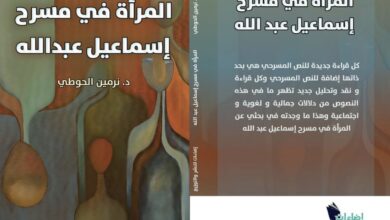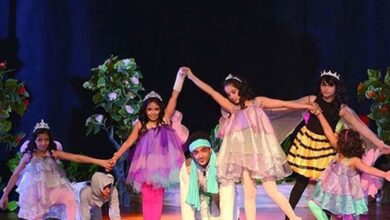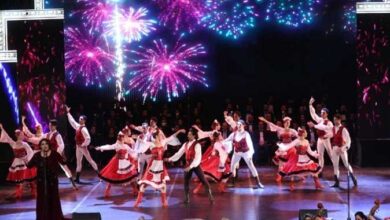On a stage awash in dramatic spotlights and equipped with giant, thumping speakers, six barefoot dancers from Ferqet el-Samteen(Silent Troupe) surround a black-clad dancer, a younger boy whose careful steps grow increasingly anxious as the circle tightens and finally engulfs him. This tense moment is part of “Friendly Fire,” a narrative piece that combines interpretive modern dance with ballet, accompanied by instrumental music. Suddenly, the music surges, signalling the appearance of a dancer in white, who approaches the young boy, now lying still inside the circle; the six murderous dancers are cued to agonized movements. It is almost impossible to believe that they didn’t hear the music swell. But every dancer in Ferqet el-Samteenis deaf.
The dancers may not be able to hear the music, but they can feel it. Through a listening technique introduced to the members by the troupe’s founder, arts and theater teacher Reda Abd el-Aziz, dancers react to the changing tempo of vibrations running through the floor from the speakers. It’s a method inspired by the 18th-century composer Ludwig van Beethoven who, when he began losing his hearing, was able to experience his compositions by feeling for vibrations off of his piano.
“I train each and every one of the troupe members by tapping on the back of their palms or their shoulders the tempo of the music, so when they are on stage they can feel the vibrations off the base speakers and are guided by the music’s tempo. I also along translate the moods of the music into sign language to make them understand the acts we are playing and to ensure a harmonic performance,” said Abd el-Aziz.
Founded in 2005, Ferqet el-Samteen (commonly known as the Egyptian Deaf and Mute Modern Dance Company) is the first performance group of its kind in the world. It includes 30 members, ranging in age from 16-23, all of whom are hearing impaired. They dance under the inspiring motto, “We can talk to the world through art and creation.”
Abd el-Aziz created the troupe after witnessing audience members at a sign language play chatting loudly with one another and talking on their cell phones, ignoring the performance. The deaf students, who had been practicing for four months, felt depressed and discouraged.
“Hearing people rarely know sign language. They only learn it if they have a family member who is deaf, which leaves the deaf and mute isolated. When they try to communicate with others, they are rarely understood. I wanted to help them communicate better, in a ‘third language’ as I like to call it,” said Abd el-Aziz, who directs and choreographs every performance.
Through the work of Ferqet el-Samteen,Abd el-Aziz hopes to create a culture that appreciates people with special needs. By giving them opportunities in the arts when they are young, he broadens their career options.
Most importantly, Ferqet el-Samteenrescues the young dancers from social isolation. Their deafness becomes incidental, not defining.
“In the past, my daughter was lonely and depressed. She didn’t even socialize with her brothers and sisters, but after the help of Reda Abd el-Aziz and working with the troupe, her life has changed from isolation and depression to happiness and hope,” said Ola Abd el-Hamid, the mother of Basma Farid, Ferqet el-Samteen‘s lead performer.
“Since I joined the troupe, I am happy all the time. I have value. I feel like a star. I am on TV and people recognize me,” added Basma, in sign language.
Each show carries an important message. “Small Wings,” the troupe’s debut, conveyed the challenges that children with disabilities face. To symbolize their isolation, the dancers hid in white shells. “Friendly Fire” promoted a UNICEF campaign to stop drugs and smoking, and “Angels Also Die” was about children suffering during wartime.
The troupe has performed at Egypt’s top cultural venues, such as the Cairo Opera House, the French Cultural Center, and the Sawy Cultural Wheel, and has been featured on TV and covered widely in the press. But, in spite of their notoriety and success, Ferqet el-Samteenwas unsuccessful in its bid for financial support from the Ministry of Culture.
“We requested the financial support from the Ministry of Culture several times, but they only help with nominal donations. We don’t need donations, we need a sponsor to finance the troupe and provide us with a fixed place for our performances in Cairo,” said Heba Abd el-Fattah, the media relations consultant for Ferqet el-Samteen.
Up to now, the troupe has been financed by Abd el-Aziz, but as it grows, so does the cost of operating it. Abd el-Aziz made several requests that the Ministry of Culture include the troupe in national cultural events, and recently reached a deal with Mohamed Abu Seada, the head of the Cultural Development Fund; last month, Ferqet el-Samteenperformed at an event in the Talaat Harb Cultural Center, organized by the Cultural Development Fund. Their financial request, however, has not been granted.
This financial strain extends to the families of troupe members, who depend partially on the money their children make dancing. Before they became members of Ferqet el-Samteen, they would likely have contributed to the household income by working at a family business or elsewhere.
Still, there’s hope for Ferqet el-Samteen, as it continues to garner positive attention. Art critic Rafik el-Saban, the late German theater director Pina Bausch, and the Italian dancer and choreographer Samira Nur el-Ain have all praised the troupe. In fact, Nur el-Ain, who specializes in Arabic dancing, plans to visit the members of Ferqet el-Samteenin September with a group of Italian dancers to give workshops and learn about Ferqet el-Samteen‘s unconventional methods.
Nur el-Ain will also join the troupe in two performances: “Cleopatra,” in which she will play the lead, and “Tears of Joy,” the troupe’s most famous folkloric dance show, which they plan to dedicate to Mahmoud Reda and Farida Fahmy, the leaders of modern Egyptian folkloric dance.
Amr el-Gammel, a music editor and composer who has worked closely with the troupe for three years, expressed concern about the future of Ferqet el-Samteen. “The deaf and mute children are natural artists who have excellent skills and can follow the hardest melodies. They inspire people with peace and calmness. We should fight for their message to spread.”




